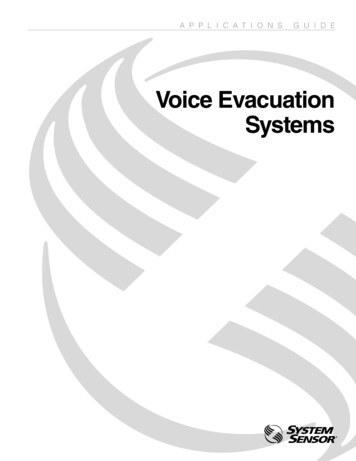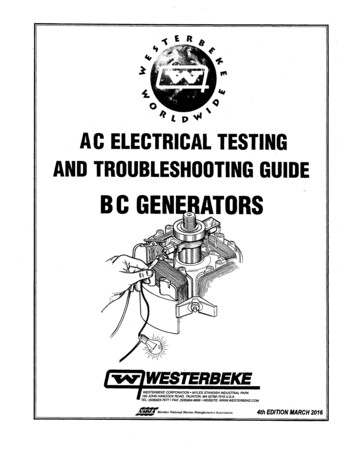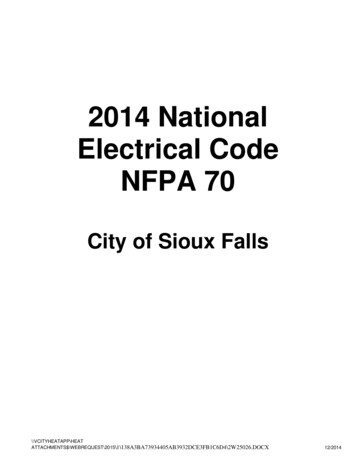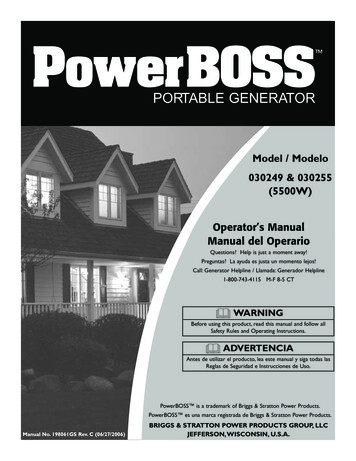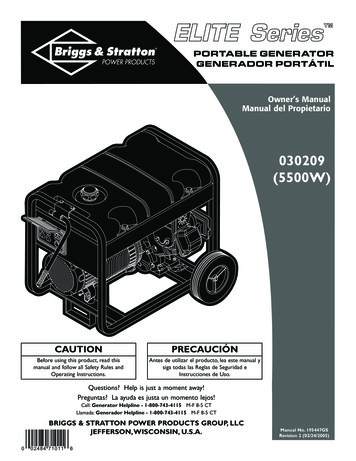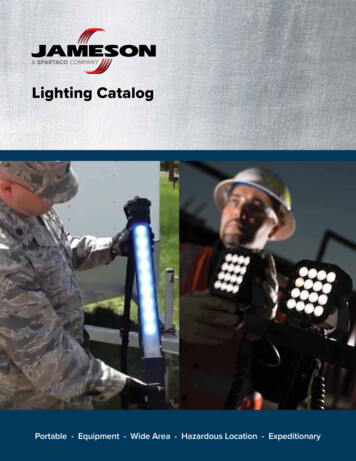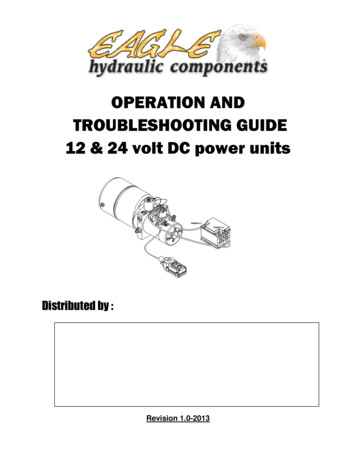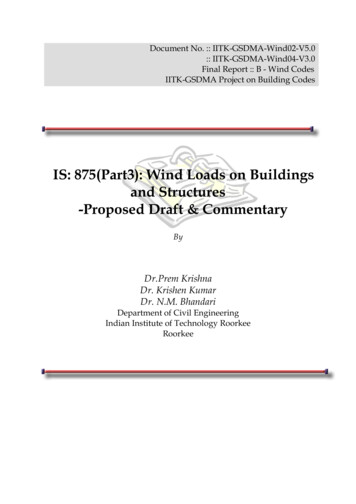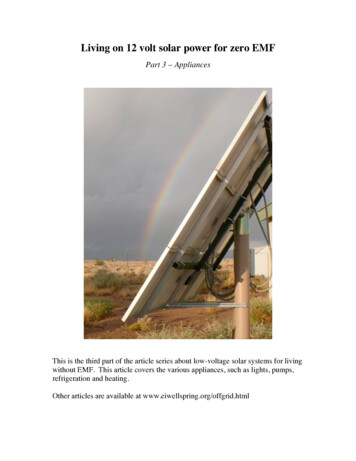
Transcription
Living on 12 volt solar power for zero EMFPart 3 – AppliancesThis is the third part of the article series about low-voltage solar systems for livingwithout EMF. This article covers the various appliances, such as lights, pumps,refrigeration and heating.Other articles are available at www.eiwellspring.org/offgrid.html
2 Living on 12 volt – Part 3Table of Contents for Part 310. Appliances10.1Lighting10.1.1 Outdoor lighting10.2 Refrigerator10.3 Pumps10.4 Telephone system10.5 Washing machine10.6 Stove10.7 Air conditioning10.8 Water heater10.9 Home electronics10.10 Phantom loads11. Heating an off-grid house10. AppliancesHousehold appliances include lights, refrigerator, washing machine, pumps,electronics and all sorts of electrical gadgets.A solar house must have a lot fewer gadgets than the typical American home. It issimply not feasible to run it all on solar, and especially not on small 12 voltsystems. See part 1 of this article listing items that are not really possible to use insuch a house.Appliances that use motors or electronics may not be compatible with an ultra-lowEMF life, and should be used sparingly or away from the sensitive person.The solar system must be sized to power the use of the chosen appliances.The voltage produced by a solar system varies and can be anywhere between 11.5volt and 15.5 volt. The typical daily variation is from 12.5 volt to 14.5 volt. Anyappliance connected to the solar system must accept this variation. This authorhas tested multiple 12 volt devices, such as radios, TV, DVD player and laptops,which all have worked fine, but some models may not like such a variable voltage.Lights of all kinds (incandescent, halogen, LED) tend to run hotter with a highervoltage than about 13 volt. This may shorten their life span. This is a particularproblem for LED lamps.
Living on 12 volt – Part 33Many 12 volt appliances come with a cigarette outlet connector. They will not fitinto the outlets suggested here. The solution is to either make a conversion cableor replace the cigarette plug with a new plug. Make sure the polarities are correct,as reversing plus and minus can ruin many appliances.Home-built conversion cord. A cigarette outlet cable was purchasedat WalMart. The male plug was then replaced with a new male plug.Home-built extension cord and power strip for 12 volt.
4 Living on 12 volt – Part 310.1 LightingThere are many models of incandescent and halogen lights available for 12 volt,including automotive tail lamps. These all fit a regular 120 volt socket.For 12 volt and zero-EMF, there are only three types of lighting available: incandescenthalogenLEDThe incandescent bulbs are the cheapest, but also the most wasteful of electricity.They are best used only where they are on briefly, such as closets.Halogen bulbs are about 20% more efficient than incandescent bulbs, but also costmore. The halogen bulbs send out some UV-light, but that is largely blocked byglass. Most models come with a glass enclosure and putting it in a glass fixtureshould block most UV.LED lights are costly, but are a must where the lights may be on for many hours.This especially includes where the lights may be accidentally left on, such asporch lights.
Living on 12 volt – Part 35Most 12 volt LED lights do not have built-in electronics (unlike 120/240 voltmodels, which all do). A few 12 volt models do have electronics, which are bestavoided in a low-EMF home.The quality of the light from LEDs takes some time to get used to. Some sensitivepeople cannot tolerate it, so experiment. Some people do better with LED lampsthat are reflected off a wall or ceiling. They are getting better, and this may soonnot be an issue.There are very few 24 volt lights available. Currently, the selection is limited to afew LED lights and some automotive light bulbs. An alternative is to wire two 12volt lamps in series or build your own.LED lamps run hot when the voltage is above 13 volt. This shortens their life andmay result in dead or flickering LEDs. It is best not to run LED lights during theday, or while charging with a generator, where the voltage will rise above 13 volt.Most RV-type 12 volt lamp fixtures are plastic, which can smell when heated by the lamp.They are also not very durable.
6 Living on 12 volt – Part 3Regular light fixtures work very well for 12 volt.120 volt table lamp, converted to 12 volt with a new cord. The built-in switch is notsuitable for DC voltage, so an external switch is used (not shown).
Living on 12 volt – Part 3710.1.1 Outdoor lightingVisitors to off-grid neighborhoods often notice the lack of “security lights” (andhow bright the stars are, due to the lack of light pollution). Brightly illuminating ahouse is not really realistic with 12 volt solar systems, and it is rarely neededanyway, as they do not deter burglars.LED lights are a must for outdoor lighting, as they are so efficient. For peoplewho can’t tolerate LED lights, much can be accomplished with driveway reflectorsand motion detector activated lamps.12 volt LED porchlight10.2 RefrigeratorThe choice of refrigerator is limited to either 12/24 volt models or a gas fridge. Itcosts about the same to purchase either type, when including the solar panelsneeded for the 12/24 volt models. As a propane refrigerator consumes about twogallons (9 liters) of propane a week, the solar powered models are the mosteconomical in sunny climates.A gas fridge should not be kept inside a house, as it does emit combustion fumes.Some people keep them in a closet on the outside of the house, on a porch or in agarage. Some people have attached chimneys to them, though some fumes maystill get into the room. RVs have direct venting of gas refrigerators, which seemsto work well.
8 Living on 12 volt – Part 3However, a gas fridge is totally noiseless and can be totally free of EMFemissions. This may be the decisive factor for a low-EMF house.Beware that some gas fridges have built-in electronic controls, which may be aproblem. These controls cannot be turned off. Check before buying.The 12 and 24 volt refrigerators use DC motors. A DC motor puts out a lot moreEMF than an AC motor, and it backfeeds strong dirty power onto the house’selectrical wires. In a low-EMF house, these types would need to be in anoutbuilding and preferably fed by a separate solar system to prevent backfeeding.A third option may seem to be some RV fridges, which use either 12 volt orpropane. However, these have an electric heating element which consumes 200–300 watts, which is way too much electricity to be viable for a solar system.The small 12 volt thermoelectric coolers are not very effective. They also use toomuch electricity and the DC fan motor is problematic.Some people have gotten along for years using ice chests. A well-insulated largecooler would need a bag of ice about three times a week. It cannot keep thingsfrozen, but it works well for refrigerated foods.
Living on 12 volt – Part 310.3 PumpsThe Shurflo model 2088 12 volt pressure pump, which can serve both a showerand a faucet at the same time.A rural home often has its own well, which means there are one or two pumps.There may also be a circulation pump for a hydronic heating system.There are several 12 and 24 volt pumps available for various uses. A pump mustbe selected for each specific situation.For a shallow well, one pump may be sufficient. For a deeper well, there may beone pump that pumps to a holding tank and another that takes water from the tankand fills a small pressure tank.The well may be serviced by a special pump that runs off separate higher voltagesolar panels or a small wind generator. This tends to be rather expensive.A cheaper solution is to have a conventional 240 volt pump in the well, which isnow and then powered by a generator, while filling the water tank. The generatorcould then also power a washing machine at the same time.9
10 Living on 12 volt – Part 3The D5-38 vario 12 volt circulation pump from LAING, used for in-floor heating system.The noise level, amount of dirty electricity and EMF emissions can vary greatlyamong pumps of the same type. This author tested two circulation pumps andfound the LAING D5 model superior to the EL-SID.The water pressure in an off-grid system is typically lower than a city or an ongrid system, to save resources. The booster pump typically comes on when thepressure drops to 20 psi (1.4 bar/140 kps) and stops when it reaches 40 psi(2.8 bar/280 kps). A pressure tank of nominally 20 gallons (76 liters) strikes agood balance between the pump coming on too frequently, versus running for along time, which can be hard on the battery.Pressure pumps are noisy and best located in an outbuilding. If placed in thehouse, it could wake people up at night. A remedy could be to use a large pressuretank and then ensure that it is filled at times when the noise is acceptable. If usinga large tank, the pump would run for longer times when it does run. Make sure thebattery is up for it.Some people put their pumps on a separate solar system. This prevents dirtyelectricity from travelling on the household wiring. A separate system could alsobe used for well pumps that requires a higher voltage, such as 48 volts.The lower water pressure in off-grid houses is rarely a problem, though a reverseosmosis (RO) water filter would probably need a non-electric pressure booster.
Living on 12 volt – Part 3 11The pumps used can usually produce about 3 gallons per minute (34 l/min). Thisworks for a household with one or two people, who can simultaneously run twofaucets (low-flow slower and toilet or sink).10.4 Telephone systemA simple telephone is powered by the telephone landline and does not needelectricity from the solar system. This is often the best solution.Fancier phones and caller-ID displays that are not battery powered are on 24 hoursa day, so even though they may not consume much wattage, it may add up overtime. Such phones can also backfeed dirty power onto the house wiring and maynot be a good idea for very sensitive people.Cordless phones always consume extra power and also radiate 24 hours a day.They simply do not belong in a low-EMF home at all.Answering machines should be avoided. If voice mail is available, that is a muchbetter solution. If an answering machine must be used, there are devices availablethat first turn it on when the phone rings, and to possibly power it directly on DC.See the catalog from Backwoods Solar for details (see resources).10.5 Washing machineA washing machine is essential for sensitive people, as using a laundromat islikely to contaminate the clothes with fabric softener, fragrances and otherchemical products used by other people.There are no low voltage DC washing machines available and the little handcranked camping models are not practical for daily use.Two options available are to power a 120 volt model with: a generatoran inverter from the solar systemThe generator option is usually the simplest, cheapest and safest for a sensitiveperson.Using an inverter would require a larger solar system and the inverter may beintolerable. The Staber brand washer is specifically designed for use with aninverter, and it consumes much less electricity than regular models.
12 Living on 12 volt – Part 3A third option is to have a dedicated washer located at someone else’s house.In some climates, it is feasible to hand wash and line-dry clothes year round.Lehman’s sells a plunger-like washing device, and a washer with a paddlemechanism, which both work well (see resources).10.6 StoveCooking using solar power is not realistic, especially not with a 12 volt system. Asolar cooker can be a great help in a sunny climate, but it cannot do it all, even inthe hot desert.Some sort of gas-fired stove will be needed. It will need to be outside, or in aseparate extremely well ventilated room or enclosure. Totally outside is best, forinstance on a porch, sheltered from the wind.A simple camping stove can work very well. A gas-powered bar-be-cue grill is agreat complement, both for grilling food and also for baking foods (cover the grillwith two cookie sheets).Full size gas stoves are available, though most actually do require 120 volt AC tofunction. Only two companies in the U.S. manufacture non-electric gas stoves:Peerless-Premier and Brown Stove Works. Verify that the selected model doesnot require any power.10.7 Air conditioningAir conditioners can simply not be run from a 12 volt solar system. They consumetoo much electricity.Swamp coolers can be used in dry climates. There are 12 and 24 volt swampcoolers available (see resource section). These do use DC motors which can bevery bothersome to sensitive people and may need to be run from a separate solarsystem. A swamp cooler also makes a house humid, which can promote moldgrowth. The pads may contain biocides as well. Swamp coolers work only in dryclimates.Some people design their house for passive cooling, using large roof overhangs toshade the house, smaller windows, low-E glass, thermal mass and other methods.This may not be enough in a hot climate.
Living on 12 volt – Part 3 1310.8 Water heaterFor heating water for bathing and chores, there are four options: firewoodsolarpropane/natural gasgeneratorSome woodstoves can also heat water. Some models can be used outside, perhapsonly fired up once a day for hot water.Solar water heaters may provide hot water for some or all of the year, dependingon the climate. Some people bathe in the afternoon on winter days, when hotwater is available, and not at all on dark days.A gas-fired water heater is probably the best option for most people. It works verywell if kept in a separate ventilated space that is sealed off from the rest of thehouse. Most gas water heaters do not require any electricity, but some fancymodels do. Make sure the gas line does not at all come in through the house, asthey tend to leak with age.A generator can be used to power an electric water heater, but that is a veryexpensive way to heat water, besides the other drawbacks such as noise, EMF,inconvenience, etc.
14 Living on 12 volt – Part 310.9 Home electronicsBoom box that normally uses eight D-cell batteries (8 x 1.5 volt 12 volt)which is now run off the household 12 volt system.Home electronics such as computers, TVs, radios etc. are usually problematic forvery sensitive people. But many of us do use them to a limited extent.A battery powered radio is a common example. Some larger radios and boomboxes can be run directly from a 12 volt system. A regular car stereo can also beused on 12 volt.There are 12 volt televisions and DVD players available from some large truckstops, RV stores and places selling car electronics. Brands include NAXA andSkyworth.A more elaborate setup is to have a satellite TV receiver located on an outbuilding,which houses a DVD recorder. The recorded DVDs are then played on a DVDplayer inside the house. The outbuilding should have its own totally separate solarsystem and a small sinewave inverter (250 watts or so) to run the electronics.Such an outbuilding should be located about a hundred yards (100m) from thehouse.Most laptop computers can be run on 12 volt. A special cigarette-outlet cable mayneed to be purchased. They are usually more tolerable when run from the internalbattery, so some people only use it that way and charge it up again while they arenot home.
Living on 12 volt – Part 3 15Fast internet service, such as DSL/ADSL, coax and fiber-optic may be moredifficult. They all require a sophisticated modem that is powered by 120 volt AC.The modem can be turned off when not needed, but powering the modem from a12 volt system without an inverter may not be possible. Some models may use anexternal power supply. In that case, it may be possible to replace the powersupply with the household 12 volt.SIRIUS satellite radio, which runs on eight batteries (12 volts) and comes with acigarette-outlet cord.Electronics which need a lower voltage (such as 6 or 9 volt) could be served bythrow-away or rechargeable batteries. It may also be possible to run them fromthe 12 volt system using a linear power supply (not a voltage converter). A linearpower supply can be made by someone handy with simple electronics, thecomponent needed is called LM317.
16 Living on 12 volt – Part 3Portable DVD player which is charged from 12 volt, using a conversion cable.Very few pieces of electronics require more than 12 volt. This author has onlyseen a water softener and a few printers and fax machines.If a necessary item needs more than 12 volts, it may be necessary to build a smallseparate 24 volt solar system to power it, or use disposable/rechargeable D-cellbatteries.Fax machines, inkjet printers, etc. may also be powered by 12 volts for certainmodels that have an external power supply that generates 12 volts or less (checkthe label). It is not realistic to power laser printers and large photocopiers using 12volts, as they use too much electricity.10.10 Phantom loadsThe phantom loads are things that consume electricity round the clock, eventhough they are turned “off” and are not really doing anything that matters.Examples of phantom loads are clocks, some TVs and radios, cordless phones,idling computers, battery chargers, etc. In a typical American home, the phantomloads can be quite substantial. In an off-grid ultra-low-EMF house, they should beeliminated.
Living on 12 volt – Part 3 1711. Heating an off-grid houseThere are not many realistic options for heating a house safely and with only lowvoltage electricity. They are basically:– propane/natural gas– wood– solarThe sun can provide a lot of heat in sunny climates, but in almost all cases someother heat source is needed as well.Some people with MCS use wood heat and do well with it, but many cannottolerate the smoke. It is important to use a high quality wood stove to reduce thesmoke around the house. The main exposures to smoke and soot are then whenservicing the wood stove.Pellet stoves require electricity for the feeder mechanism and are probably notpractical for 12 volt off-grid homes.One option is to buy an outdoor wood furnace which heats water that is piped intothe house. They are only serviced once or twice a day, but it is still a lot of smokeexposure to maintain it.Propane or natural gas can work very well if the fumes and any gas leaks are keptstrictly outside the living space. This means no gas appliances in the houseno gas pipes in the houseno forced air heatingIn practice, that means the boiler/water heater must be outside the house, in anoutbuilding or a closet on the side of the house. The house is heated by hot waterpiped through the floor (in-floor heating) or radiators. It may be possible toretrofit in-floor heating or radiators in an existing house.Some manufacturers claim their products have sealed combustion chambers, butexperience shows they do not work for people with MCS.An alternative is direct-vent heaters that are mounted on exterior walls in eachroom of the house. They take in fresh air and return exhaust directly through thewall. The record for these is spotty, and they cannot presently be recommended.
18 Living on 12 volt – Part 3Any other type of heater, regardless of claims of “catalytic” or “vent not needed”will probably not work for sensitive people.
Living on 12 volt – Part 3 7 10.1.1 Outdoor lighting Visitors to off-grid neighborhoods often notice the lack of “security lights” (and how bright the stars are, due to the lack of light pollution). Brightly illuminating a house is not really realistic with 12 volt solar systems, and i
